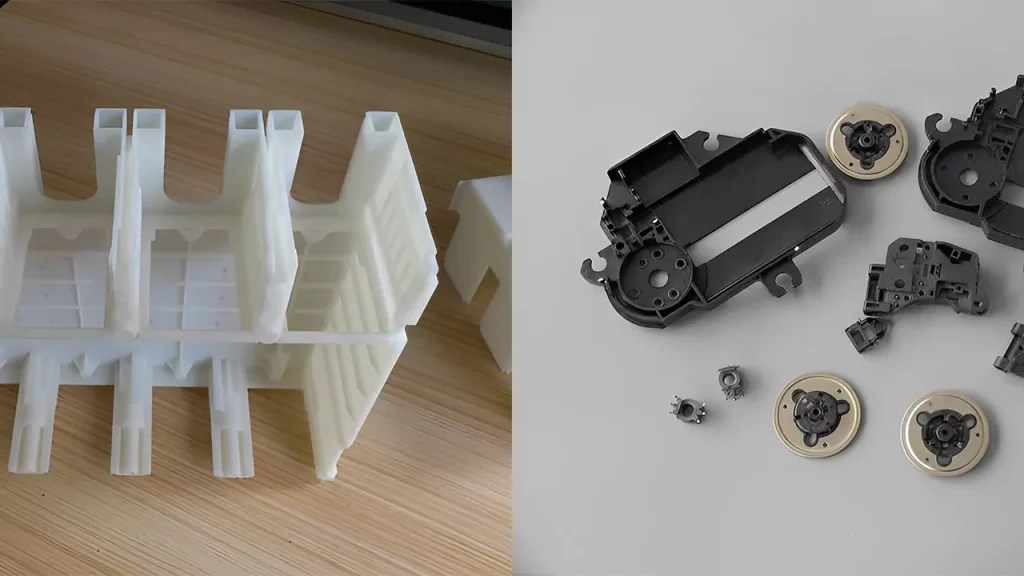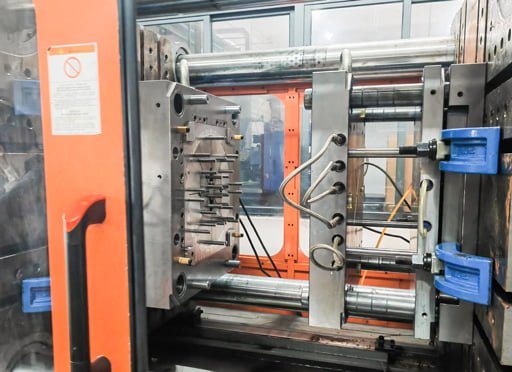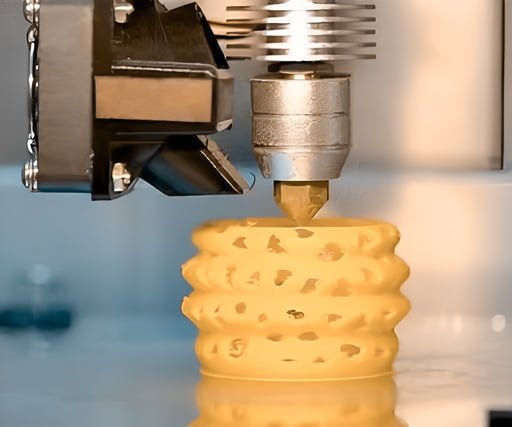Probablemente ya esté considerando posibles métodos de producción para su proyecto. Entonces, ¿qué método de producción es mejor? ¿Impresión 3D o moldeo por inyección, y por qué?

Con esta guía detallada, le ayudaremos a elegir entre moldeo por inyección y Impresión 3D para dar vida a su proyecto comparando y contrastando ambos procesos y destacando sus respectivos puntos fuertes y débiles.
Elegir bien la fabricación:
Entre la impresión 3D y el moldeo por inyección, ambos son excelentes procedimientos de fabricación, pero son muy distintos y pueden ayudar a completar proyectos diversos. Esto depende totalmente de sus necesidades. Aunque el moldeo por inyección parece más profesional, las cosas están cambiando y la impresión 3D se está convirtiendo en una alternativa viable que permite crear piezas extremadamente exactas.
Estas dos estrategias pueden ayudarle en sus procesos de creación rápida de prototipos y de producción. Ambas tienen ventajas, pero ¿cuál beneficiará a su proceso de fabricación? Para ello, primero debe entender en qué consisten estos procesos.
Definición:
- Moldeo por inyección:
El moldeo por inyección, un método industrial común utilizado durante décadas, consiste en inyectar material fundido en la cavidad de un molde para crear un producto. En este proceso de fabricación, se inyecta el material fundido en el molde, que se solidifica al enfriarse y da forma al producto.
- Impresión en 3D:
Por otro lado, fabricación aditivaLa impresión 3D consiste en construir un objeto capa por capa. Con este método, se necesita un archivo 3D para iniciar el proceso de fabricación; no es necesario un molde. Hoy en día, puedes hacerte con una gran variedad de tecnologías y materiales de impresión 3D.
Los beneficios:
- Ventajas del moldeo por inyección
Cuando se trata de fabricar grandes volúmenes, el moldeo por inyección tiene muchas ventajas. El proceso se agiliza gracias a su precisión y repetibilidad. El moldeo por inyección le permite fabricar cosas con una amplia variedad de calidades, ya que puede utilizar una gran variedad de materiales, desde plástico hasta metales.
El moldeo por inyección es especialmente útil para fabricar a gran escala. Este método es ideal para fabricar un producto con contornos y ornamentos complicados. Puede adaptar la resistencia, flexibilidad u otros atributos físicos de una pieza a la aplicación prevista seleccionando el material adecuado entre las muchas opciones disponibles.

- Ventajas de la impresión 3D
Al comparar la fabricación aditiva con métodos más convencionales como el moldeo por inyección, quedan claras sus numerosas ventajas. En primer lugar, funciona mejor con diseños iterativos, por lo que si su proyecto es todavía un trabajo en curso, este método es para usted.
Durante mucho tiempo, prototipado rápido se consideraba el uso ideal de la impresión 3D. Pero ya no es así, y no lo ha sido durante algún tiempo porque la tecnología ha mejorado y se ha vuelto más fiable. A pesar de ello, la creación de prototipos es uno de sus puntos fuertes porque puede hacerlo rápidamente y con menos residuos que otras técnicas.
Antes de volver a imprimir, puedes probar tu idea con una impresión sencilla y hacer los ajustes necesarios en el software de modelado 3D. A continuación, puede imprimirla y volver a comprobar su trabajo antes de enviarlo para su publicación. A medida que perfeccione el diseño de su producto, esta adaptabilidad le ahorrará tiempo y dinero.
Con la impresión 3D, casi no se desperdicia material. Todo lo que hay que utilizar es el número de materiales necesarios para la tarea. Esta es una ventaja significativa en comparación con las técnicas de fabricación convencionales como control numérico por ordenador (CNC) y moldeo por inyección.
Si puede imprimir su diseño bajo demanda, puede evitar tener materiales adicionales a mano, lo que puede aumentar el coste. La impresión de productos acabados bajo demanda elimina la necesidad de almacenar o gestionar la cadena de suministro, ya que elimina estos problemas.

La diferencia:
En cuanto a la superioridad del proceso de fabricación, tanto el moldeo por inyección como la impresión tridimensional tienen argumentos de peso a su favor. Sin embargo, todo depende de los requisitos que usted tenga en mente. Ambos métodos de impresión tridimensional frente al moldeo por inyección presentan ventajas únicas y características favorables. Entre ellas:
- Diferencia de costes:
Los métodos de moldeo por inyección suelen requerir maquinaria cara, y algunas máquinas alcanzan precios de cientos de miles de dólares. Por otro lado, invertir en una de calidad superior puede proporcionarle años o incluso décadas de servicio.
Quienes trabajan por cuenta propia o desarrollan sus productos pueden considerar que adquirir una no es el uso más productivo de sus recursos financieros. No es algo que uno quiera comprarse a sí mismo. Sin embargo, existe una solución más económica: contratar a proveedores de servicios especializados en moldeo por inyección.
El hecho de que necesite moldes hechos específicamente para su producto es otro factor que contribuye al elevado coste. Esto podría añadir varios miles o decenas de miles de dólares al coste total.
La impresión de objetos tridimensionales con una impresora 3D es mucho más asequible que el moldeo por inyección. En primer lugar, la impresora es mucho más asequible. Dispone de una amplia variedad de posibilidades entre las que elegir, por lo que, independientemente de si trabaja en producción o como aficionado, no debería tener problemas para encontrar el producto más adecuado para satisfacer sus necesidades y completar sus proyectos. El coste de una impresora 3D suele rondar los miles de dólares, pero no hay gastos adicionales por adelantado porque no es necesario construir un molde a medida.
Del mismo modo, varias empresas ofrecen ahora servicios de impresión 3D además del moldeo por inyección. Este método es aún más económico, ya que los únicos costes en los que se incurre son los asociados al uso de la máquina y los ingredientes. Por otra parte, las nuevas impresoras que se están fabricando en la actualidad hacen posible que incluso las empresas industriales más pequeñas puedan hacerse con sus propios dispositivos.
- Diferencia de tiempo:
Cuando se trata de la duración que se necesita para completar un ciclo de producto de impresión 3d y moldeo por inyección, el moldeo por inyección es el procedimiento que lleva menos tiempo. Sin embargo, esto no es todo para el proceso porque el desarrollo, fabricación y perfeccionamiento de moldes puede tomar un tiempo significativo.
Un molde a medida de acero o aluminio puede llevar semanas o meses. Si confía en un proveedor de servicios, es posible que le exijan esperar el tiempo de máquina asignado. Debido a estas diversas consideraciones, el plazo de entrega será bastante mayor de lo normal. Sin embargo, una vez que todo esté organizado, realizar su función no debería llevarle demasiado tiempo.
El proceso de impresión en 3D no requiere ningún tipo de plazo de entrega. Usted está preparado para seguir adelante una vez que el diseño se ha completado utilizando el software que tiene. La impresión de su componente llevará algún tiempo; en la mayoría de los casos, unas pocas horas.
- Diferencia de volumen:
El volumen de fabricación es la principal área en la que el moldeo por inyección y la impresión tridimensional divergen significativamente. El moldeo por inyección sigue siendo el método preferido para la producción de grandes volúmenes, aunque la impresión tridimensional ahorra una cantidad significativa de dinero en el equipo y los materiales utilizados.
El moldeo por inyección es la técnica que debe utilizar para producir lotes de decenas de miles de piezas a la vez o más. Con estos elevados índices de producción, su inversión financiera en la fabricación del molde ideal y en la adquisición de una máquina debería amortizarse por sí sola y algo más.
Por otro lado, la impresión 3D es una opción excelente para necesidades de volumen bajo a medio. Los ejemplos más convincentes en esta categoría son la creación de prototipos y la producción bajo demanda. Este es el enfoque más eficaz cuando se busca un método de creación de prototipos que sea fácil para el bolsillo.
También puede reducir sus costes reduciendo la cantidad de almacenamiento, ya que puede imprimir sólo cuando lo necesite. La tecnología de impresión 3D también ha avanzado hasta el punto de poder generar sus modelos de forma razonable, lo que hace posible fabricar tiradas que se cuentan por miles.
¿Cómo utilizarlos? Impresión 3D vs. Moldeo por inyección:
Moldeo por inyección:
No se puede utilizar esta tecnología sin emplear equipos específicos. Para emplear el moldeo por inyección, se necesitan máquinas especializadas específicas. Una tolva de materialLas máquinas de moldeo por inyección están equipadas con un cilindro de inyección, un pistón de inyección y una unidad de calentamiento.
La fabricación de moldes para su método de moldeo por inyección es una operación costosa que limita sus opciones de creación de prototipos: Los moldes pueden ser bastante caros de recrear cada vez que necesite hacer numerosas iteraciones. Dado que estos moldes suelen estar compuestos de acero, realizar ajustes es difícil y no pueden adaptarse a su desarrollo de prototipos.
Sin embargo, es una opción viable si pretende crear grandes cantidades. Recuerde que este proceso sigue teniendo costes del utillaje de moldeo por inyección y un largo plazo de entrega necesario.
Impresión en 3D:
En términos de aplicación, la impresión 3D difiere del moldeo por inyección. Existen numerosas aplicaciones para la fabricación aditiva. Si necesita un filamento de impresión 3D, puede adquirir una impresora 3D, como una FDM (Modelado por deposición fundida). Su empresa puede adquirir impresoras 3D más grandes y profesionales, como las impresoras 3D SLS (sinterización selectiva por láser). Sin embargo, la compra de su impresora 3D industrial puede ser una inversión costosa para su empresa, y puede que no merezca la pena.
También puede recurrir a un proveedor de servicios de impresión 3D como Prototool. Las tecnologías de impresión 3D utilizadas por estos proveedores de servicios le ayudarán a crear todas sus mejores ideas, desde metal hasta plástico y resina. Al contratar a empresas profesionales para que le ofrezcan el servicio, puede elegir entre varias tecnologías, como Multi Jet Fusion, CLIP (DLS), DMLS e impresión 3D.
Conclusión:
En última instancia, sus necesidades determinarán por completo el proceso/la tecnología que elija para Impresión 3D frente a moldeo por inyección. Ambos tienen sus propias ventajas, características y resultados. Sin embargo, puede mezclar estos dos métodos para sacar el máximo partido de lo que hacen mejor: ¡todo depende de sus exigencias de producción!










